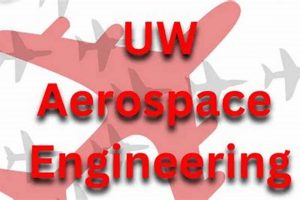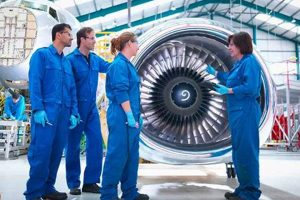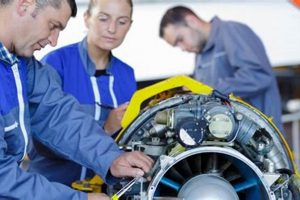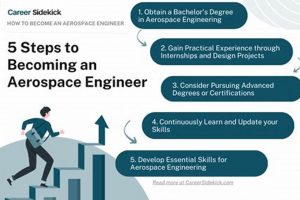The discipline encompassing the design, development, testing, and production of aircraft and spacecraft is a multifaceted field. It integrates principles from aerodynamics, propulsion, materials science, structural analysis, and control systems. For example, creating a new generation of fuel-efficient commercial airliners or designing probes for deep-space exploration fall under the purview of this engineering domain.
Expertise in this field is critical for advancing technological capabilities in aviation, space exploration, and national defense. Innovations arising from research and development in this area contribute significantly to economic growth, scientific discovery, and global connectivity. Historically, advancements have spurred major societal shifts, impacting transportation, communication, and even our understanding of the universe.
A comprehensive examination of flight vehicle design processes, propulsion system advancements, and contemporary research areas will be discussed subsequently. Further focus will be placed on materials development and structural integrity considerations within this context.
The following guidelines are intended to assist those engaged in the rigorous pursuit of mastering the principles and practices central to the engineering of flight vehicles and related technologies. Adherence to these points can enhance understanding and improve overall performance within this demanding field.
Tip 1: Prioritize Foundational Knowledge: A robust understanding of core principles, including fluid mechanics, thermodynamics, and structural analysis, is paramount. Inadequate preparation in these areas will hinder progress in more advanced topics.
Tip 2: Emphasize Computational Skills: Proficiency in relevant software tools for modeling, simulation, and analysis is indispensable. Familiarity with programs such as MATLAB, ANSYS, and SolidWorks is highly recommended.
Tip 3: Engage in Practical Application: Theoretical knowledge must be supplemented with hands-on experience. Seeking opportunities to participate in design projects, research initiatives, or internships can provide invaluable real-world exposure.
Tip 4: Cultivate Interdisciplinary Collaboration: Aerospace projects often require collaboration across multiple engineering disciplines. The ability to effectively communicate and work within a team is essential for successful outcomes.
Tip 5: Stay Abreast of Technological Advancements: The field is characterized by rapid innovation. Continuous learning and professional development are necessary to remain competitive and contribute meaningfully to the advancement of the discipline.
Tip 6: Develop Strong Problem-Solving Abilities: The ability to identify, analyze, and solve complex engineering problems is crucial. This skill is honed through rigorous coursework, practical application, and independent research.
Tip 7: Focus on Systems-Level Thinking: Flight vehicles are intricate systems with numerous interacting components. A holistic understanding of the system as a whole is necessary for effective design and analysis.
These guidelines, when consistently applied, should improve comprehension, bolster practical skills, and ultimately lead to greater success in the academic and professional pursuit.
Building a strong foundation and staying updated on technological advancements are key. The next section will discuss specific applications and future trends.
1. Aerodynamics
Aerodynamics, the study of air and other gaseous fluid motion, constitutes a fundamental pillar within the broad discipline of flight vehicle engineering. Its principles dictate the performance characteristics of aircraft and spacecraft, directly influencing factors such as lift, drag, stability, and control. Understanding aerodynamics is not merely theoretical; it is essential for the successful design, operation, and safety of all flight vehicles.
- Lift Generation
Lift, the force that opposes gravity, is generated by the pressure difference between the upper and lower surfaces of an airfoil (wing). The shape of the airfoil, along with the angle of attack (the angle between the wing and the oncoming airflow), determines the magnitude of the lift produced. Efficient lift generation is crucial for enabling flight and maximizing payload capacity. Aircraft wings and control surfaces (ailerons, flaps) are aerodynamically designed to optimize lift characteristics.
- Drag Reduction
Drag, the force that opposes motion through the air, is an inevitable consequence of aerodynamic interaction. Minimizing drag is essential for improving fuel efficiency, increasing speed, and extending range. Various strategies, such as streamlining the vehicle’s shape, using laminar flow airfoils, and employing boundary layer control techniques, are employed to reduce drag. The design of fuselages, engine nacelles, and even wingtips are all optimized to reduce aerodynamic drag.
- Stability and Control
Aerodynamic forces and moments significantly influence the stability and control characteristics of a flight vehicle. Stability refers to the vehicle’s tendency to return to its equilibrium state after a disturbance. Control surfaces, such as rudders, elevators, and ailerons, are used to generate aerodynamic forces that allow the pilot (or autopilot) to control the vehicle’s attitude and trajectory. Careful aerodynamic design is necessary to ensure adequate stability and responsiveness to control inputs. For example, vertical stabilizers (tails) provide directional stability, preventing uncontrolled yawing motions.
- Supersonic and Hypersonic Aerodynamics
At supersonic (faster than the speed of sound) and hypersonic (Mach 5 or greater) speeds, the behavior of air changes dramatically. Shock waves form, causing significant increases in drag and heat transfer. The design of flight vehicles intended for these speeds requires specialized aerodynamic considerations, such as sharp leading edges, swept wings, and heat-resistant materials. Understanding the complex aerodynamic phenomena associated with high-speed flight is crucial for developing effective supersonic and hypersonic aircraft and missiles.
The principles of aerodynamics are interwoven into every aspect of design. By optimizing these facets, engineers can create safer, more efficient, and higher-performing aircraft and spacecraft. The continuous evolution of aerodynamic knowledge and techniques remains central to the future of flight vehicles.
2. Propulsion Systems
The development and implementation of effective propulsion are fundamental to flight vehicle engineering. Propulsion systems generate the thrust required to overcome drag and gravity, enabling aircraft and spacecraft to achieve and maintain flight. The selection and design of propulsion systems are critical decisions that significantly impact performance, efficiency, and mission capabilities.
- Gas Turbine Engines
Gas turbine engines, including turbojets, turbofans, and turboprops, are widely used in commercial and military aircraft. These engines operate by compressing air, mixing it with fuel, igniting the mixture, and extracting energy from the hot exhaust gases to generate thrust. Turbojets provide high-speed thrust, turbofans offer improved fuel efficiency, and turboprops are suited for lower-speed applications. For example, the CFM International LEAP engine used on the Boeing 737 MAX and Airbus A320neo families of aircraft demonstrates the fuel efficiency improvements achieved through advanced gas turbine technology.
- Rocket Engines
Rocket engines are used for spacecraft propulsion and high-speed aircraft. These engines generate thrust by expelling hot gases produced from the combustion of a propellant, typically a fuel and an oxidizer. Rocket engines can operate in the vacuum of space, making them essential for orbital maneuvers, interplanetary travel, and satellite launches. The SpaceX Merlin engine, used on the Falcon 9 rocket, exemplifies a reusable rocket engine technology that significantly reduces launch costs.
- Electric Propulsion
Electric propulsion systems, such as ion thrusters and Hall-effect thrusters, utilize electrical energy to accelerate propellant ions, generating thrust. These systems provide very high specific impulse (a measure of fuel efficiency) but produce relatively low thrust. Electric propulsion is well-suited for long-duration space missions, such as orbit raising, station keeping, and deep-space exploration. The Dawn spacecraft, which explored the asteroid belt, used ion propulsion to achieve significant velocity changes over its mission.
- Advanced Propulsion Concepts
Research and development efforts are continuously exploring advanced propulsion concepts to improve performance and enable new mission capabilities. These concepts include hypersonic propulsion systems (e.g., scramjets), pulsed detonation engines, and fusion propulsion. Hypersonic propulsion is crucial for developing vehicles capable of sustained flight at speeds greater than Mach 5. The development of scramjet technology is a significant challenge but promises to revolutionize air and space travel.
The integration of a carefully selected system within a flight vehicle is crucial. The efficiency, thrust, weight, and reliability of the chosen system directly influences the operational capabilities. Continuing advancements in these areas drive the ongoing development and deployment of advanced aircraft and spacecraft. The close link between advancements in propulsion and overall progress in the field ensures that propulsion system innovation will continue to be a central focus. The selection and optimization significantly contribute to the advancement of aircraft and spacecraft capabilities.
3. Structural Integrity
The preservation of structural integrity is paramount within the field of flight vehicle engineering. It represents the capacity of an aircraft or spacecraft to withstand applied loads and environmental conditions without catastrophic failure. This capability is not merely a desirable attribute; it is a non-negotiable requirement for safe and reliable operation. The design, materials selection, manufacturing processes, and maintenance protocols are meticulously scrutinized to ensure that the vehicle’s structure can endure the stresses encountered throughout its operational lifespan. For instance, the Comet airliner disasters of the 1950s highlighted the critical importance of understanding metal fatigue and its impact on structural longevity, leading to significant changes in aircraft design and testing methodologies.
The influence of the discipline extends beyond initial design considerations. It impacts operational parameters, maintenance schedules, and even the service life of flight vehicles. Rigorous testing and inspection procedures are employed to detect potential structural weaknesses before they lead to failure. Non-destructive testing methods, such as ultrasonic inspection, radiography, and eddy current testing, are routinely used to assess the condition of critical structural components. Data collected from these inspections informs predictive maintenance strategies, allowing for proactive repairs and replacements that prevent catastrophic failures. The implementation of advanced composite materials in modern aircraft, while offering significant weight savings, also necessitates sophisticated methods for detecting and characterizing damage, highlighting the ongoing evolution of structural integrity assessment techniques.
In summary, it is a critical element. Ensuring structural integrity is a multifaceted challenge that demands a comprehensive understanding of materials science, mechanics, manufacturing, and operational environments. The continuous pursuit of improved methods for design, analysis, and inspection is essential for enhancing the safety, reliability, and longevity of flight vehicles. The consequences of structural failure can be severe, underscoring the unwavering commitment to rigorous standards and continuous improvement within this critical domain.
4. Materials Science
Materials science stands as a cornerstone discipline underpinning all facets of flight vehicle engineering. The selection, development, and application of materials directly dictate aircraft and spacecraft performance, safety, and longevity. Advancements in materials science are often the catalyst for breakthroughs in aerodynamic design, propulsion efficiency, and structural capabilities.
- High Strength-to-Weight Ratio Materials
The pursuit of materials with high strength-to-weight ratios is a constant endeavor. Reducing weight enhances fuel efficiency, increases payload capacity, and improves maneuverability. Aluminum alloys, titanium alloys, and advanced composites (such as carbon fiber reinforced polymers) are extensively used in aircraft structures. For instance, the Boeing 787 Dreamliner utilizes a significant proportion of composite materials in its fuselage and wings, resulting in substantial weight savings and improved fuel economy.
- High-Temperature Materials
Components in propulsion systems and hypersonic vehicles are subjected to extremely high temperatures. Materials capable of withstanding these conditions without significant degradation are essential. Nickel-based superalloys, ceramic matrix composites, and refractory materials are employed in turbine blades, combustion chambers, and heat shields. The Space Shuttle’s thermal protection system, composed of ceramic tiles, exemplifies the importance of high-temperature materials for re-entry vehicles.
- Corrosion and Environmental Resistance
Flight vehicles operate in harsh environments, exposed to corrosive agents, UV radiation, and extreme temperature variations. Materials resistant to corrosion and environmental degradation are crucial for maintaining structural integrity and preventing premature failure. Protective coatings, corrosion-resistant alloys, and specialized surface treatments are employed to mitigate these effects. The selection of appropriate materials for fasteners and joints is also critical in preventing galvanic corrosion.
- Damage Tolerance
Even with careful design and rigorous testing, aircraft structures can experience damage due to fatigue, impact, or manufacturing defects. Materials with high damage tolerance, capable of withstanding damage without catastrophic failure, are essential for ensuring safety. Fracture mechanics principles are applied to design structures that can tolerate cracks and other imperfections. The use of crack arrest features and the incorporation of toughened materials can enhance damage tolerance.
The synergistic relationship underscores a continuous drive for lighter, stronger, more durable, and environmentally resistant materials. Innovations in materials science have fueled advancements in aircraft and spacecraft design, enabling new capabilities and pushing the boundaries of flight vehicle technology. As the demands on flight vehicles continue to increase, the role of materials science will only become more critical in shaping the future of aerospace engineering.
5. Control Systems
Control systems constitute an indispensable element within flight vehicle engineering. These systems manage the dynamic behavior of aircraft and spacecraft, ensuring stable and predictable operation across a wide range of flight conditions. They are integral to maintaining desired trajectories, altitudes, and orientations, while also mitigating the effects of external disturbances. Without sophisticated control systems, safe and efficient operation is impossible.
- Flight Control Surfaces and Actuation
Flight control surfaces (e.g., ailerons, elevators, rudders) are manipulated by actuation systems to generate aerodynamic forces that control the vehicle’s attitude and trajectory. These actuation systems can be hydraulic, electric, or electromechanical, and their performance directly impacts the responsiveness and precision of the control system. For instance, fly-by-wire systems, common in modern aircraft, replace mechanical linkages with electronic controls and actuators, enabling enhanced maneuverability and stability. The control system interprets pilot inputs and autonomously adjusts control surfaces to achieve the desired flight path.
- Navigation and Guidance Systems
Navigation systems determine the vehicle’s position, velocity, and attitude, while guidance systems generate commands to steer the vehicle towards its intended destination. These systems rely on a variety of sensors, including inertial measurement units (IMUs), GPS receivers, and radar altimeters. In spacecraft, star trackers and sun sensors are used for attitude determination. The integration of navigation and guidance systems enables autonomous flight, precision landing, and accurate orbital maneuvers. The guidance system on the Apollo missions, for example, used inertial navigation to guide the spacecraft to the moon and back.
- Stability Augmentation Systems
Stability augmentation systems (SAS) enhance the inherent stability of a flight vehicle and reduce pilot workload. These systems use sensors to detect undesirable motions and automatically apply corrective control inputs. SAS can be particularly important for aircraft with unconventional designs or those operating in turbulent conditions. Yaw dampers, common in commercial aircraft, are a type of SAS that minimizes Dutch roll oscillations, improving ride comfort and handling qualities.
- Autopilot Systems
Autopilot systems provide automated control of the flight vehicle, allowing the pilot to delegate tasks such as maintaining altitude, heading, and airspeed. Advanced autopilot systems can also perform complex maneuvers, such as automatic landings and precision approaches. Autopilots reduce pilot fatigue, improve fuel efficiency, and enhance safety. Modern commercial aircraft feature sophisticated autopilot systems that can manage nearly all aspects of flight, from takeoff to landing.
The seamless integration of these control systems is critical. The continued advancement and innovation in the field improves safety and efficiency. The development of more sophisticated sensors, robust control algorithms, and reliable actuation systems is driving the evolution of flight vehicle technology.
6. Systems Integration
Systems integration represents a critical facet within the field of flight vehicle engineering, encompassing the complex process of combining individual components and subsystems into a unified, functional whole. Effective integration is not simply a matter of physical assembly; it requires meticulous planning, rigorous testing, and iterative refinement to ensure that all elements operate harmoniously and meet specified performance requirements. The successful development of any aircraft or spacecraft is inextricably linked to the effectiveness of the systems integration process.
The challenges inherent in systems integration are multifaceted. Flight vehicles are comprised of numerous interconnected systems, each with its own distinct functionality and operational characteristics. These systems must be compatible with one another, both physically and functionally, to avoid interference or performance degradation. For example, integrating a new radar system into an existing aircraft requires careful consideration of power requirements, electromagnetic compatibility, and potential impacts on the aircraft’s aerodynamic properties. Furthermore, the integration process must account for factors such as weight, size, maintainability, and cost.
Real-world examples underscore the practical significance of systems integration. The development of the F-35 Lightning II fighter jet, for instance, involved the integration of advanced sensors, communication systems, and weapon systems into a single platform. The success of this project hinged on the ability to effectively integrate these disparate elements while meeting stringent performance and reliability requirements. Similarly, the design of a Mars rover requires the integration of scientific instruments, power systems, communication systems, and mobility systems. The success of these missions is dependent on the ability of the integrated system to function reliably in the harsh environment of space.
In conclusion, systems integration is fundamental to the successful development and deployment of any aircraft or spacecraft. Effective integration requires a holistic approach that considers the interactions between all components and subsystems. The increasing complexity of flight vehicles demands increasingly sophisticated integration techniques, reinforcing the importance of this discipline within the broader field of aerospace engineering.
Frequently Asked Questions about the field
This section addresses common inquiries and misconceptions regarding the study and practice of engineering as it relates to flight vehicle design and technology. The aim is to provide clear and concise answers to enhance understanding of this complex and multifaceted discipline.
Question 1: What distinguishes this field from other engineering disciplines?
The core distinction lies in its specialized focus on the design, development, and production of aircraft, spacecraft, and related systems. This encompasses unique considerations related to aerodynamics, propulsion, structural integrity under extreme conditions, and control systems optimized for flight environments. While drawing upon fundamental engineering principles, it applies them within the highly specialized context of atmospheric and space flight.
Question 2: What are the primary career paths available after completing formal education?
Graduates typically pursue careers in the aerospace industry, government agencies, and research institutions. Common roles include design engineer, propulsion engineer, structural analyst, flight test engineer, systems engineer, and research scientist. Opportunities exist in both the commercial and military sectors, as well as in space exploration and satellite technology.
Question 3: What fundamental skills are essential for success in this field?
A strong foundation in mathematics, physics, and computer science is essential. Proficiency in computational analysis tools, CAD software, and programming languages is also highly valued. Additionally, effective communication, teamwork, and problem-solving skills are critical for collaborative projects and addressing complex engineering challenges.
Question 4: What is the role of research and development?
Research and development are central to advancing the field. Ongoing research focuses on improving fuel efficiency, reducing emissions, developing new materials, enhancing safety, and enabling new capabilities in flight. These efforts drive innovation and ensure the continued progress of aerospace technology.
Question 5: What are the emerging trends shaping the future?
Several trends are poised to reshape the field. These include the development of electric and hybrid-electric propulsion systems, the increasing use of autonomous systems and artificial intelligence, the expansion of commercial spaceflight, and the growing focus on sustainable aviation practices. These advancements offer exciting opportunities for innovation and growth.
Question 6: What is the significance of systems engineering within this context?
Given the complexity of flight vehicles, systems engineering plays a crucial role in ensuring that all components and subsystems function together seamlessly. It involves defining system requirements, managing interfaces, conducting trade studies, and verifying that the integrated system meets performance objectives. Effective systems engineering is essential for minimizing risks and maximizing the success of aerospace projects.
In summary, the field demands a combination of technical expertise, analytical skills, and a commitment to continuous learning. As technology continues to evolve, professionals must remain adaptable and embrace new challenges to contribute meaningfully to the advancement of flight vehicle technology.
The next section will explore the historical context and future outlook of aviation and space exploration.
Concluding Remarks on vt aerospace engineering
This exposition has provided an overview of vt aerospace engineering, encompassing its foundational principles, essential strategies for practitioners, key components such as aerodynamics and propulsion, structural integrity considerations, the role of materials science, and the importance of systems integration. It has also addressed common questions, aiming to clarify the scope and nature of this complex engineering domain.
The ongoing advancement of flight vehicle technology demands continued innovation and expertise. The future of air and space exploration relies on the dedicated efforts of engineers and scientists committed to pushing the boundaries of what is possible. The pursuit of knowledge and technological advancement in this area remains a critical endeavor for global progress.


![Best Aerospace Engineering Colleges in Kentucky [Ranked] Innovating the Future of Flight with Reliable Aviation Solutions Best Aerospace Engineering Colleges in Kentucky [Ranked] | Innovating the Future of Flight with Reliable Aviation Solutions](https://mixaerospace.com/wp-content/uploads/2025/12/th-760-300x200.jpg)




